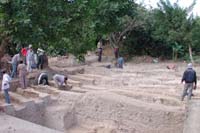
| sondages dans le cimetière latin décembre 2002 Cliché : © CEA - tous droits réservés |
|
Latest news from the sites December 2002 |
| First of all, news from the sites recently finished, | >general index< |
| The salvage excavation of the Caesareum (former Garage
Lux) was closed as previously planned on 31 August. We were able to reach
bedrock and then return the site to the developers, who will eventually
transform the site into a vast shopping mall. We are now waiting for a group
of shop owners who occupy the last quarter of this large area to be relocated.
This section, the old "French Market", which we have regarded with some
envy for the past ten years, has only a few months left... CThis dig has furnished us with a variety of information about the topography of Alexandria. We uncovered medieval cisterns, a Christian cemetery connected to the church of the Caesareum, remains of the Imperial temple itself including a superb statue of an emperor (Marcus Aurelius or Septimius Severus) wearing a breastplate, a chamber with a coffered ceiling covered with stucco and decorated with still coloured nelumbos, as well as sections of columns of impressive diameter. |
| and then those which continue... |
|
As for the underwater excavations, they continued in both spring and autumn of 2002 : On the monumental site lying under some 6 to 8 metres
of sea off Qaitbay Fort we continue the cartography using an Aquameter,
an underwater acoustic measuring tool that we obtained last year. Meanwhile, the documentation of the shipwrecks progresses with the drawing of the amphoras of QB2, and the location of a new shipwreck, thanks to a team of Greek geophysicists from Patras, appears promising. It is settled in the mud and holds a cargo of Late Roman 1 amphoras. For the moment, only the top layer of fused amphoras is visible. We will have to define a strategy for this new site, and, of course, adequate financing. |
| Our publications have continued to appear at a regular rate : |
| There have been two new additions to the series Etudes alexandrines (volumes 7 and 8), published by the IFAO. These are entitled Necropolis 2 and Alexandrie médiévale 2. The next volumes will concern the underwater excavations and the numismatics conference which was held in the CEA last spring. |
| We are also working on exhibition projets |
| One will cover Alexandria's cisterns and the hydraulic system of the city during its long history. This should be mounted in Marseille's Musée d'Histoire in autumn 2004. In the same year, the Cathédrale d'Images at Baux-de-Provence will house a visual spectacle presenting our on-site work. Images of the modern town and of our land digs (most notably in the necropolis and the cisterns) as well as our underwater explorations will be projected onto walls more than 20 metres high. |
|
And lastly, The support of the Ministries of Research, National Education and Foreign Affairs is as strong as ever. However, 2002 was a patricularly difficult year for finding sponsors, probably because of the various elections that took place in France. It was only in autumn that we were able to restart discussions with large industrial groups in the hope of some solid support for the coming year. Such a situation only serves to underline our appreciation of 200-odd faithful members of the Friends of the CEA. Their moral and financial support is a constant encouragement in our ongoing efforts to save what is left of the Capital of the Ptolemies, and for that we thank them warmly. |
| Jean-Yves Empereur | |
| Director of CEA | |
| previous pages : |